What size generator do I need? Overview
This post will help to determine the size of the generator that you might need.
Many people ask, ‘What size generator do I need?’ and, honestly, it is a far simpler question to answer than you may think.
You will need to make just a few considerations, and we will talk about those on this page.
Where are you using the generator?
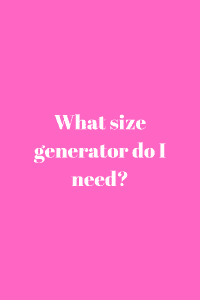
If you are using the generator in a house, then it is unlikely that you will need to move it about too often.
This means that you will be able to choose a generator that is in excess of the wattage that you need.
If you are camping or in an RV, you need to pay close attention to how many watts you need because the more powerful the generator, the heavier it will be. This means that it will be difficult to move about.
What size generator do I need?
For the most part, you will need to go around your home or your RV and add up the watts of each appliance and device that will be plugged into the system at once. This should give you a figure that you can work with.
Do bear in mind that the wattage listed on your appliances and devices will only be the ‘running wattage’.
This is the power they consume while they are switched on. Some appliances will have a surge in wattage.

This is the amount of power they consume when you turn them on initially. This will be far higher than the standard wattage, and if you fail to consider this when considering which generator to use, it will cause power surges.
For example; a fridge may have a running wattage of 600, but when you turn it on, it may take upwards of 2000 watts for a while.
Obviously, if you are in a house you won’t be switching it on and off all the time, but in an RV, the power of the fridge may be switched off on occasion, and if you opt for a low watt generator, you will need to stagger switching on appliances to ensure the generator doesn’t surge.
What calculation can you use?
In light of this, add up the following:
The wattage of every appliance make a note of the ‘start up’ wattage. if this isn’t listed on the appliance, it will be in the manual. Add 1000 watts on to be sure
A house will (generally) use about 5000-6000 watts. An RV may be anywhere between 2000 watts and 4000 watts, dependent on what you have running.
How to calculate what size generator I need
There are a lot of important factors to consider when buying a generator, but none more important than the size of the generator i.e. the amount of power it is able to pump out.
So, if you are asking the question ‘How to calculate what size generator I need’, then this is the right page to be on.
Why the size of the generator is important
There are a few reasons why the size of your generator is important:
How portable it will be, how many appliances or devices it can power cost
You want to get a fine balance between all three of these. Obviously, if you are setting up the generator permanently in your home, then portability won’t matter as much as it would if you had an RV.
However, you will still need to consider whether there is enough power there to ensure your home can run smoothly.
You also do not want to have more power than you need, because the cost of this is going to quickly add up.
How to calculate what size generator I need?
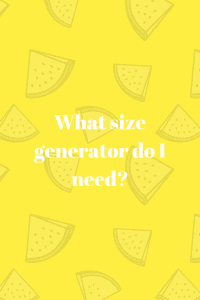
It actually isn’t as hard as you may think.
The first thing you will need to do is add up the wattage of all your appliances and devices.
You will also need to consider whether these will all be running at once.
You may want to list appliances that will always be running (fridge and freezer etc.) and then plan to have some devices turned off at certain times to ensure you do not overload your generator.
You will also need to consider ‘start-up’ power wattage. This is the power consumption the appliance or device consumes when switched on.
This won’t be listed on the appliance itself, so you may need to go through the manual.
It is important because if you do not account for this and you are pretty close to your ‘wattage’ on the generator, absolutely everything in your home will switch off at once, meaning a reboot of the system.
Generator sizing formula
Getting the right side of the generator is important in saving money and getting enough power supply.
This means you have to know the generator sizing formula to get the right size.
There are some factors to consider when working out the generator size.
Appliances
To get the right size of the generator, you need to know the amount of power you’ll be consuming.
This means working out the amount of power your appliances use.
Add the wattage of the appliances and remember to include both the running and starting watts. In some cases, these may be equal but sometimes they are not.
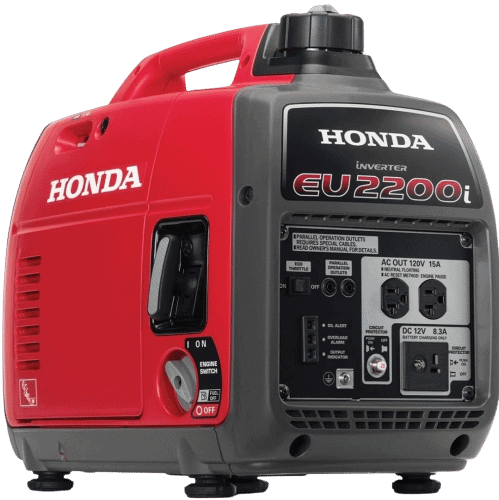
The starting watts refer to the power consumed when the appliance is turned on, and the running watts is the power the appliance continues to consume.

To sum up, this section, Once you get the total wattage in kilowatts (kW), you’ll have to convert them into kilo volt-amperes (kVA) which is the standard reading of generators.
This means you have to know how to convert the kW into kVA and vice Versa.
This also means you need to know the efficiency of the system which is also known as the power factor.
Generators have that factor as 0.8. To get the kVA, divide the total wattage by the power factor.
Converting the kVA to kW, on the other hand, requires multiplying the kVA with the power factor.
• kW /0.8 (power factor) =kVA
• kVA * 0.8 = kW
Other factors to consider when calculating the total power include:
• Operation time refers to how long you expected to keep the generator running. The longer it remains on the more the power consumption.
• The location of the generator: this will affect the ease with which the generator is maneuvered.
• Other power supplies: if you only intend to use the generator as a backup then the power consumption will be low.
However, if it is the primary source of power then you’ll need a bigger size.
Generator Size Guide (Tips And Tricks)
Acquiring a generator that can supply power is a critical exercise. The hardest part of it all is determining the right generator size you need to meet your requirements.
Generator size variations
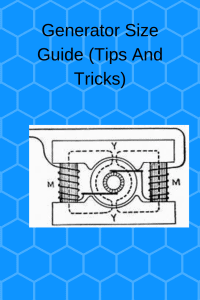

With the current trend of technology advancement in the field of electric engineering, we now have a wide range of generator sizes available.
There are those designed for household uses their sizes range from 5kW to 50kW. These are convenient for personal use at home.
For industrial generators the sizes available range from 50kW to 3 Megawatts. There are also handy generators that are available for homes, small offices and RVs.
Large businesses, data center buildings, and industries, however, need to utilize industrial generators of large sizes to meet their desired requirements.
Generator sizing, how much power?
There are many individuals out there who still believe that smaller generators can be used for standby electric power because they are not running all the time. This kind of belief can be very detrimental.
Generator under-sizing indeed is one of the most common mistakes usually committed by buyers.

It can lead to damage of your asset beyond repair. This means all the appliances connected to it may be at risk of damage.
Moreover, it may even limit the overall productivity of the business or unit relying on it for power supply.
How to determine the right size of a generator

It is true that an electric technician is the best person to inspect and calculate all you need to know about the size of a generator.
However, one should avoid going to a generator dealer and buying the cheapest of them all. One should at least look at the following in order to determine the right size.
-You need to make a list of items that you will require to be run electric power from the generator.
-you also need to make a note of the starting and running wattage of the given respective items
-you also need to calculate the total power requirements in the form of KW or KVA
How do you find the starting and running wattage?
What you need to do look for is the owner’s manual or the identification plate of all the appliances you intend to use.
On the part of ampere-watt conversion, you will first note the recorded amount and then convert it using this formula;
-For resistive load, wattage equals amperes multiplied by volts.
-For reactive load, wattage is equal to amperes multiplied by volts multiplied by the load factor.
Generator sizing calculator Excel
Generators are devices that can be confusing at times. Generator sizing calculator excel saves you all this headache.
This sizing calculator is able to give you the correct, reliable kW rating. The moment you have the accurate kW reading then getting the right generator becomes a piece of cake. It saves you a lot of trouble trying to figure out which size suits you best.
Generac generator sizes
Choosing the right Generac generator size is not easy. Here are some of the things you need to consider in order to choose the right size of your Generac generator.
Power Capabilities
One of the most critical considerations when choosing the right Generac generator is whether it will meet its intended purpose of supplying sufficient power to your intended appliances.
Coming from one-phase 120V for the regular household needs to that of three-phase 208V and beyond, it is probably wise to step up the generator that provides the next level of power that you possibly require.
Consider the generator’s sound output.
Sometimes these generators can be so noisy. These high noise levels can be an issue, especially in residential areas.
Therefore, you should choose a generator designed to operate quietly.
Look at the portability requirements.
This is one of the very first things one looks when purchasing a generator.
You must understand there is a real difference between permanently installed backups and portable generators. So you will consider according to the requirements and the needs you have.
Cooling system
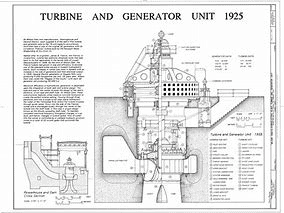
You should know that generic generators come in either air-cooled or liquid-cooled models.
Air cooling system is usually convenient for generators of small sizes like those used for household purposes. It is an economical method too.
A more powerful liquid cooling system is preferred for large-size generators meant for industrial purposes.
The above discussion clearly describes how one can choose a generator according to its size.
It is important to understand the sizes of these devices so that one can easily identify the generator that will meet their desired purpose.
House Generator Size
Being left in the dark during an outage is never a fun experience, as a generator is a great way to receive immediate power without having to wait for the lights to come back on.
However, many people are unsure of the size of their generator that they will need to power their homes.
Here are a few things to remember if you are curious about your house generator size.
Figure Out Your Starting Wattage
The first step is to determine your starting wattage for all the appliances and fixtures you want to power in your home.
It is important to find a generator that is powerful enough to provide plenty of power for everything in need of electricity.
Add All of the Wattage Together
The next step is to combine all the wattages to determine your electrical needs.
It is important to find a generator that offers plenty of power to avoid overloading and causing additional stress on the system.
Related articles
